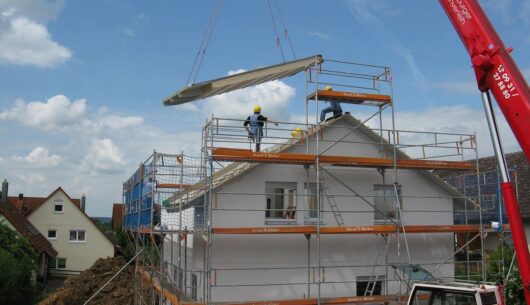Blog
Frame or brick house – which one to choose?
Nowadays, there are more and more new ideas for building houses. The choice of new construction technologies is wide: modular construction, expanded clay, perlite blocks, steel structures, but by far the most common solutions are traditional (brick) construction and skeleton construction (with a light wooden structure), which has been dynamically gaining popularity for several years. Thus, the question that future investors most often ask themselves is which house to choose – brick or frame? In order to make a good decision for us, it is worth considering all the most important differences that separate these two completely different technologies.
Table of contents
- Frame or brick house – construction time
- Costs of laying a brick and frame house
- Brick or frame house – which one to choose?
Frame or brick house – construction time
Compared to brick houses, the construction of which can take up to 3 years, the main advantage of wooden frame houses is their very short construction time. The developer’s state can be achieved even in 2 to 4 months, and another up to 2 months for finishing. Thanks to the fact that prefabricated elements are delivered to the construction site, the activities on the construction site run smoothly. What is more, such construction does not require the use of heavy equipment. The time gained brings us closer to moving to a new home faster.
Costs of laying a brick and frame house
One of the most financially burdensome stages of the investment is the construction of the foundations of the house. Depending on the ground conditions on the plot, due to the lightness of the frame structure, the foundations can be “slimmed down”, which can give significant savings at the cost of steel and concrete.
Use of a frame or brick house – ventilation
In terms of ventilation costs, traditional construction is gaining an advantage, in which you can use, if you want, cheaper gravity ventilation. On the other hand, in frame houses it is impossible and it is necessary to install mechanical ventilation with heat recuperation. However, it should be emphasized that the mechanical version of ventilation is much more efficient, ecological and cheaper to operate.
Energy consumption and heating costs
When considering the choice of a frame or brick house , it is worth considering the issue of their thermal insulation. Timber frame buildings will heat up quickly, but also lose heat faster compared to brick buildings. The possibility of faster cooling in winter will result in the need for higher heating expenditures, especially with the use of traditional heating solutions.
House structure and sound insulation
In the case of frame houses, it will be necessary to incur larger investments in sound insulation, both from the outside and inside of the building between floors. Special soundproofing and sound-absorbing solutions will be required, which will not be necessary in the case of brick houses.

Brick or frame house – which one to choose?
It is difficult to unequivocally decide which technology will be more beneficial for us. Therefore, it is worth considering:
- our expectations regarding the future house (e.g. brick technology ensures greater durability and noise attenuation, while timber frame technology ensures a high microclimate of use);
- when we want to move into a new house – a definite advantage of frame construction;
- and very important – in the question “frame or brick house” – costs. Both construction (expensive, modern frame technologies and the inability to build them using a much cheaper economic method Vs. high costs of long-term labor for brick houses) and the costs of subsequent operation of a given type of building.
The choice is not the easiest one, but regardless of whether it is a brick or frame house, the most important thing is that we live in it well, comfortably and safely for many years.
We also encourage you to read an interesting blog post on the topic: how to build a house for PLN 100,000?